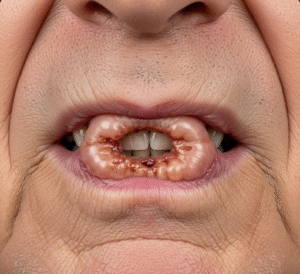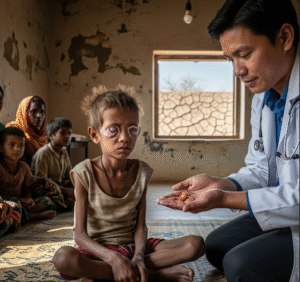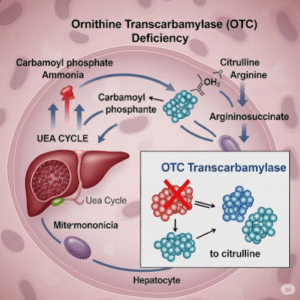Overview
Tularemia, also known as rabbit fever or deer fly fever, is a rare but highly infectious bacterial disease caused by Francisella tularensis. It primarily affects wild animals, including rabbits, rodents, and ticks, but humans can become infected through direct contact with animals, insect bites, inhalation, or contaminated food and water. Although uncommon in South Korea, awareness and surveillance are maintained due to the disease’s high infectivity and potential for severe illness. Korean medical centers provide early diagnosis, advanced laboratory testing, and effective antibiotic treatment to control infection and prevent complications.
What is Tularemia?
Tularemia is an infectious disease caused by Francisella tularensis, which can invade multiple tissues in the human body. The form of the disease depends on how the bacteria enter the body:
- Ulceroglandular tularemia: Skin ulcer and swollen lymph nodes, usually after a tick or insect bite
- Glandular tularemia: Enlarged lymph nodes without skin ulcers
- Oculoglandular tularemia: Eye infection following contact with contaminated material
- Oropharyngeal tularemia: Ingestion of contaminated food or water, causing sore throat and digestive issues
- Pneumonic tularemia: Lung infection via inhalation, potentially life-threatening
- Typhoidal tularemia: Systemic infection with fever and malaise, without localized lesions
South Korean healthcare facilities utilize modern diagnostic tools, including polymerase chain reaction (PCR), serology, and bacterial cultures, to ensure accurate diagnosis.
Symptoms
Symptoms vary depending on the type of tularemia, but common features include:
- Fever, chills, and general fatigue
- Headache and muscle aches
- Skin ulcers at the infection site (ulceroglandular form)
- Swollen, tender lymph nodes
- Sore throat and mouth ulcers (oropharyngeal form)
- Respiratory symptoms including cough, chest pain, and shortness of breath (pneumonic form)
- Eye redness, swelling, or pain (oculoglandular form)
- Gastrointestinal symptoms such as nausea, vomiting, and abdominal pain (typhoidal form)
Symptoms typically develop 3–5 days after exposure, but the incubation period may range from 1 to 14 days. Early recognition in Korean hospitals allows timely treatment to prevent severe complications.
Causes
Tularemia is caused by infection with Francisella tularensis. Infection occurs through multiple routes:
- Insect bites: Ticks, deer flies, and mosquitoes carrying the bacteria
- Direct contact: Handling infected wild animals such as rabbits or rodents
- Inhalation: Breathing in contaminated dust or aerosols
- Ingestion: Drinking contaminated water or consuming undercooked meat
- Laboratory exposure: Accidental handling of bacteria in research or diagnostic labs
Understanding these routes helps healthcare authorities in South Korea provide preventive guidance for at-risk populations.
Risk Factors
Individuals are more susceptible to tularemia if they:
- Work in high-risk occupations (hunters, farmers, veterinarians, lab personnel)
- Participate in outdoor activities in rural or forested areas
- Handle wild animals without protective gear
- Consume untreated water from natural sources
- Have weakened immune systems due to chronic illness or immunosuppressive therapy
Public health education in South Korea emphasizes risk awareness and preventive measures for vulnerable groups.
Complications
Untreated tularemia can lead to serious health complications:
- Severe pneumonic tularemia: May cause respiratory failure and require intensive care
- Systemic infection: Typhoidal tularemia can result in sepsis and organ dysfunction
- Persistent lymph node swelling or abscesses
- Eye damage from oculoglandular infection if untreated
- Gastrointestinal complications such as dehydration and malnutrition
- Secondary infections in immunocompromised patients
Timely antibiotic treatment in Korean healthcare facilities effectively minimizes these risks and ensures recovery.
Prevention
Preventing tularemia involves reducing exposure to Francisella tularensis:
- Avoid contact with wild or sick animals
- Wear gloves and protective clothing when handling animals or cleaning habitats
- Use insect repellents and protective clothing to prevent tick and deer fly bites
- Drink only treated or boiled water in rural areas
- Practice food hygiene and cook meat thoroughly
- Laboratory personnel should adhere to strict biosafety protocols
Korean public health programs provide education, awareness campaigns, and guidance for high-risk populations to prevent infection.
Treatment Options in Korea
Tularemia is highly treatable with antibiotics, and South Korea provides advanced medical care for effective management:
Diagnosis:
- Serology and PCR tests for detecting bacterial DNA
- Culture of samples from ulcers, lymph nodes, or respiratory secretions
- Imaging studies for internal organ involvement
Medical Treatments:
- Antibiotics: Streptomycin, gentamicin, doxycycline, or ciprofloxacin depending on severity
- Supportive care: Hydration, fever management, and symptom relief
- Hospitalization: Required for severe pneumonic or systemic infections
Follow-up and Monitoring:
- Monitoring to ensure bacterial clearance
- Evaluation for long-term complications such as residual lymph node enlargement or lung issues
- Education on preventing future exposure
South Korea’s combination of early diagnosis, effective antibiotic therapy, and public health measures ensures rapid recovery, reduces complications, and prevents outbreaks of tularemia.













